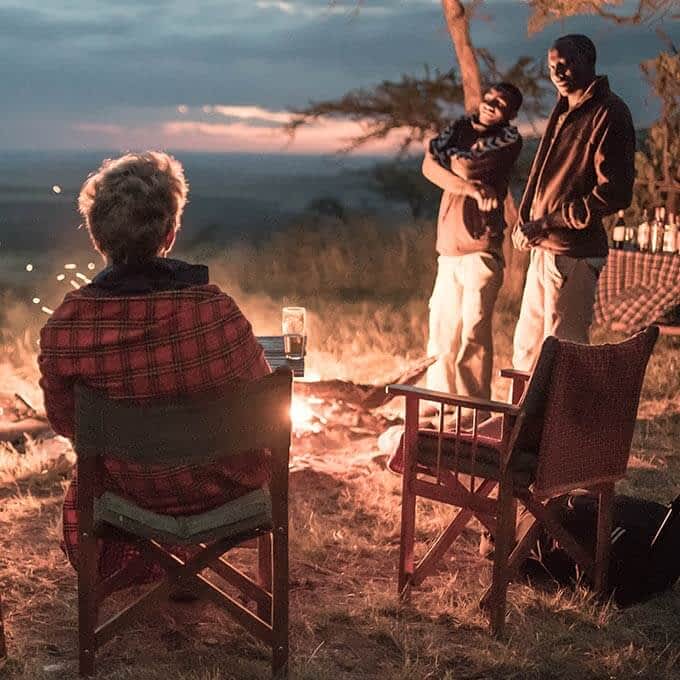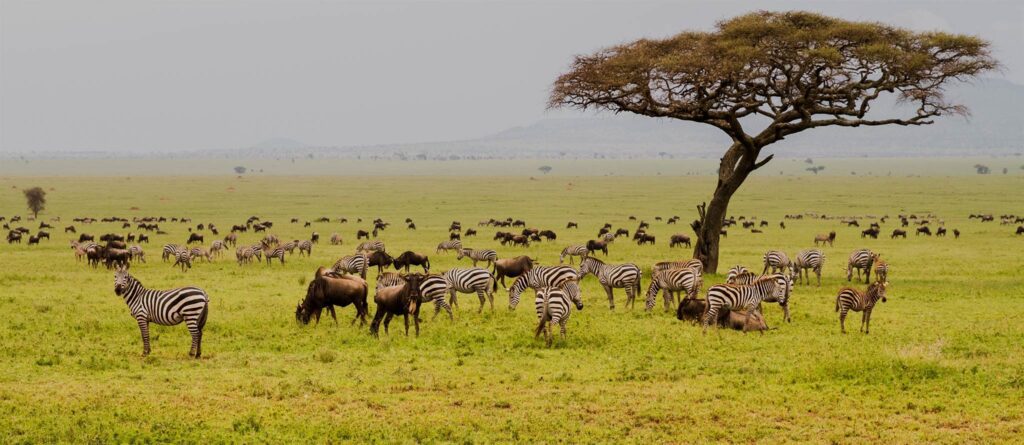One of the most common questions travelers ask is, “When is the best time to visit Tanzania?” While there are certainly peak tourism seasons, the best time to visit often depends on your personal preferences and what you want to experience. In this page we’ll help you find the ideal season for your Tanzanian adventure based on your interests and you can Explore our Tanzania safari guide articles for more info
Unlike destinations with four traditional seasons, Tanzania’s proximity to the equator and the Indian Ocean gives it a unique equatorial and tropical climate. The country experiences two main seasons: wet and dry. The wet season is characterized by rain, while the dry season is sunny and can be quite warm. Each season offers its own unique benefits, which are discussed below.
When planning your Tanzania safari tour, it’s important to remember that Tanzania’s weather patterns can be unpredictable. During the wet season, it’s not uncommon to have a sunny afternoon following a rainy morning. Similarly, occasional rain showers can occur during the dry season.
By considering these factors, you can choose the best time for your safari based on the kind of experience you’re looking for, whether it’s lush landscapes during the wet season or prime wildlife viewing during the dry season.

Tanzania is rightly famed as a premier, year-round safari destination, offering spectacular wildlife viewing regardless of the month. However, the experience of your Tanzania wildlife safari changes dramatically with the country’s distinct dry and green Tanzania safari seasons.
When planning your adventure, understanding these seasonal shifts is the key to maximizing your success. The best time to visit Tanzania is highly personal and depends entirely on your goals—whether you aim to track the sought-after Big Five in the dense bush, position yourself to witness the dramatic river crossings of the Great Migration, or capture photos of the adorable and vulnerable calving herds dotting the Southern Serengeti plains. Learn More on our Comprehensive travel guide to Tanzania
This is the best time for classic wildlife safaris across Tanzania’s major parks; Serengeti, Ngorongoro Crater, Tarangire, Ruaha, and Nyerere (Selous). During these months, rain is minimal, vegetation is sparse, and animals gather near rivers and waterholes, making them easy to find.
In the Serengeti, massive herds of wildebeest and zebra move northward toward the Mara River, where dramatic crossings occur between July and October. This is also the best period for a Great Wildebeest Migration Safari.
The Ngorongoro Crater remains lush and productive year-round, but in the dry season visibility is superb, and it’s common to see lions, elephants, and black rhinos all in one morning. Tarangire National Park offers its own spectacle as hundreds of elephants gather along the Tarangire River perfect for a Group Safari in Tanzania.
If you prefer wilderness without crowds, the southern parks like Ruaha and Nyerere National Park are excellent choices. This is prime time for a Private Safari or a Fly-In Safari to remote camps where sightings of lions, leopards, and wild dogs are frequent.
💡Quick Tip: The dry season is also the best time for photographers due to clear skies, golden light, and dramatic wildlife interactions.

The rainy season also known as the green season is when Tanzania transforms into a lush paradise. Short rains fall between November and December, followed by the long rains from March to May. While some roads may become muddy, wildlife remains abundant, and lodges offer excellent rates and quieter experiences.
Between January and March, the Southern Serengeti and Ndutu region burst with life during the wildebeest calving season, over half a million newborns appear within weeks, attracting predators like lions, cheetahs, and hyenas. This period is a dream for photographers and wildlife enthusiasts interested in predator-prey action.
It’s also the best time for birdwatchers. Migratory species arrive in the wetlands of Lake Manyara National Park, Arusha, and Selous(Nyerere National Park) making a Budget Safari in Tanzania or a Mid-Range Safari particularly rewarding.
Though rains may come and go, showers are often short-lived, and days can still be sunny. For travelers seeking a quieter, more affordable safari, the green season offers superb value without sacrificing quality.

Tanzania’s mountains including the majestic Mount Kilimanjaro, Mount Meru, and Mount Oldoinyo Lengai are officially open to trekkers and climbers throughout the entire year. However, the weather and trail conditions across the slopes vary widely with the seasons.
Choosing the best time for mountain climbing in Tanzania is the most crucial decision you will make, as it can mean the difference between achieving clear summit views and navigating through icy trails, thick mud, and persistent clouds. While no month is completely immune to rain or snow, the year is divided into distinct climbing periods that directly affect visibility, ground stability, and safety.
To maximize your chances of a successful and pleasant summit trek, use this guide to determine the ideal season for your Kilimanjaro climb or other mountain adventures based on dry weather, stable conditions, and the clearest panoramic views.

When it comes to hiking in Tanzania, particularly on iconic mountains like Mt. Kilimanjaro and Mt. Meru, the timing of your trek can greatly influence your experience. Here’s a more detailed look at what to expect during the dry and wet seasons.
Dry Season (June to October): The dry season is considered the best time for mountain hiking in Tanzania. During these months, the weather is generally cool, stable, and dry, providing the most favorable conditions for trekking.
Cool Temperatures: Daytime temperatures are typically mild, which is perfect for strenuous activities like hiking. The nights can be cold, especially at higher altitudes, but this helps reduce the risk of altitude sickness as your body has to work less to regulate its temperature.
Clear Skies: One of the biggest advantages of hiking during the dry season is the clear skies, which offer stunning, unobstructed views of the mountains and surrounding landscapes. This is especially true for Mount Kilimanjaro, where the sight of the snow-capped peak against a bright blue sky is a highlight for many climbers.
Good Trail Conditions: The dry weather keeps the trails in excellent condition, reducing the risk of slipping or getting stuck in mud. This makes the ascent safer and more enjoyable, especially on the steeper or more rugged sections of the hike.
Wet Season (November to March): While the wet season presents more challenges, it can still be a suitable time to visit Tanzania for hiking, particularly in the earlier months.
Early Wet Season (January to March): These months are warmer, which some hikers might find more comfortable, particularly in the lower altitudes. However, be prepared for occasional rain showers, which can sometimes make the trek more challenging. The trails are still passable, and the mountain is less crowded, offering a more solitary experience.
Long Rains (March to May): This period is generally not recommended for hiking. The long rains can turn the trails into muddy, slippery paths, increasing the difficulty and risk of injury. Visibility is often poor due to heavy clouds, which can obscure the beautiful views that make the trek worthwhile. Additionally, the damp conditions can make it harder to keep warm and dry, which is crucial at higher elevations
Avoid (March – May): The long rains create slippery trails, poor visibility, and a higher risk of cold, damp conditions at altitude. Most tour operators close temporarily during this period.

Tanzania’s tropical paradises of Zanzibar, Mafia and Pemba Islands are blessed with warm, inviting weather and turquoise waters throughout the entire year, making them an incredible beach escape at any time.
However, choosing the best time to visit Zanzibar, Tanzania for a relaxing beach holiday depends on whether you prioritize sunny, dry days, lower travel costs, or avoiding seasonal rainfall. The year is segmented into distinct periods that affect not only the chance of rain but also diving visibility, tidal fluctuations, and the overall density of tourists.

These months bring clear skies, calm seas, and ideal beach conditions. It’s the best time for snorkeling, diving, and cultural tours in Stone Town. Average temperatures range between 26–30°C with low humidity.
The water visibility is excellent, making this the perfect period for Zanzibar Beach Holidays or post-safari relaxation.
Rain usually comes in brief bursts followed by sunshine. The island becomes lush and green, perfect for photography. It’s also less crowded, which makes this a good time for Honeymoon Safaris that combine safari and beach.
This is the low season with fewer tourists. While heavy rains can disrupt water activities, prices drop significantly, and you’ll enjoy a more peaceful atmosphere. Resorts stay open with great value packages for those who don’t mind occasional downpours.
💡 Did You Know? Zanzibar’s diving is best from June to October (north coast) and November to March (south coast), due to shifting monsoon winds.
To help you quickly pinpoint the perfect time for your trip, we’ve created a concise Month-by-Month overview of the best time to visit Tanzania that summarizes the key conditions and major events across the country, allowing you to instantly compare the optimal times for your different travel priorities: from tracking the Serengeti Migration and planning your Kilimanjaro climb, to securing the best weather for a relaxing beach escape in Zanzibar.
Review the table below to see the wildlife movements, weather trends, and tourist crowds for every month of the year.
| Month | Conditions | Safari Highlights | Best Regions |
|---|---|---|---|
| January – February | Warm, some showers | Calving in Ndutu, birding | Southern Serengeti, Ngorongoro |
| March – May | Long rains | Lush scenery, fewer crowds | Nyerere, Zanzibar (low season) |
| June – July | Dry, cool | Migration moving north | Serengeti, Tarangire |
| August – September | Dry, warm | River crossings, best game viewing | Northern Serengeti, Ruaha |
| October | Dry to short rains | Elephants in Tarangire, end of Migration | Tarangire, Ngorongoro |
| November – December | Short rains | Green scenery, active wildlife | Lake Manyara, Nyerere, Zanzibar |
We’ll help you customize your own itinerary for a once in a lifetime adventure in Tanzania.